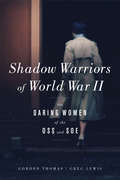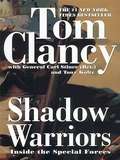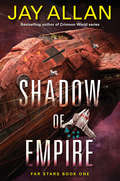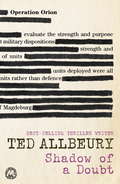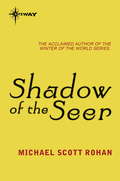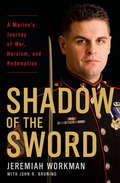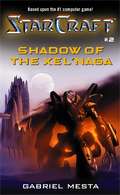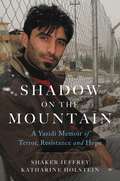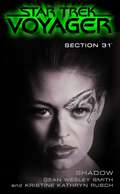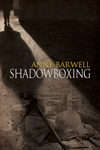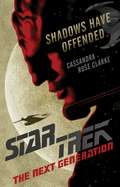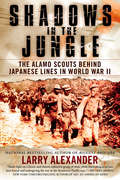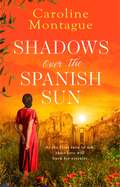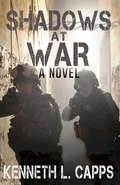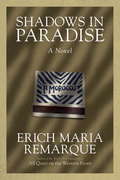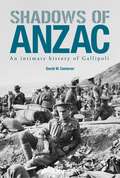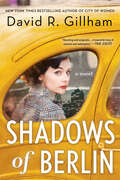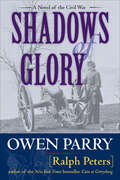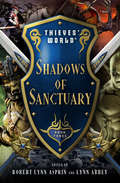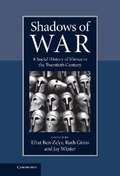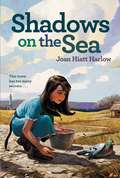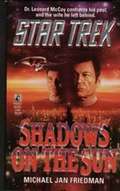- Table View
- List View
Shadow Warriors of World War II: The Daring Women of the OSS and SOE
by Gordon Thomas Greg LewisIn a dramatically different tale of espionage and conspiracy in World War II, Shadow Warriors of World War II unveils the history of the courageous women who volunteered to work behind enemy lines. Sent into Nazi-occupied Europe by the United States' Office of Strategic Services (OSS) and Britain's Special Operations Executive (SOE), these women helped establish a web of resistance groups across the continent. Their heroism, initiative, and resourcefulness contributed to the Allied breakout of the Normandy beachheads and even infiltrated Nazi Germany at the height of the war, into the very heart of Hitler's citadel--Berlin. Young and daring, the female agents accepted that they could be captured, tortured, or killed, but others were always readied to take their place. Women of enormous cunning and strength of will, the Shadow Warriors' stories have remained largely untold until now.
Shadow Warriors: Inside the Special Forces
by Tom Clancy Tony Koltz Carl StinerGreen Berets * Navy SEALS * Rangers * Air Force Special Operations * PsyOps * Civil Affairs * and other special-mission units<P> The first two Commanders books, Every Man a Tiger and Into the Storm, provided masterly blends of history, biography, you-are-there narrative, insight into the practice of leadership, and plain old-fashioned storytelling. Shadow Warriors is all of that and more, a book of uncommon timeliness, for, in the words of Lieutenant General Bill Yarborough, "there are itches that only Special Forces can scratch."<P> Now, Carl Stiner--the second commander of SOCOM, the U.S. Special Operations Command--and Tom Clancy trace the transformation of the Special Forces from the small core of outsiders of the 1950s, through the cauldron of Vietnam, to the rebirth of the SF in the late 1980s and 1990s, and on into the new century as the bearer of the largest, most mixed, and most complex set of missions in the U.S. military.<P> These are the first-hand accounts of soldiers fighting outside the lines: counterterrorism, raids, hostage rescues, reconnaissance, counterinsurgency, and psychological operations--from Vietnam and Laos to Lebanon to Panama, to Saudi Arabia, Kuwait, and Iraq, to the new wars of today...
Shadow of Empire
by Jay AllanThe first installment in the Far Star series, a swashbuckling space saga that introduces the daring pirate Blackhawk and the loyal crew of the Wolf's Claw, from the author of the bestselling Crimson Worlds saga.Smuggler and mercenary Arkarin Blackhawk and the crew of the ship Wolf's Claw are freelance adventurers who live on the fringe of human society in the Far Stars. A veteran fighter as deadly with a blade as he is with a gun, Blackhawk is a man haunted by a dark past. Even his cynicism cannot banish the guilt and pain that threaten his sanity.Sent to rescue the kidnapped daughter of his longtime friend Marshal Augustin Lucerne, Blackhawk and his crew find themselves drawn into one deadly fight after another. When the Wolf's Claw is damaged, they are forced to land on a remote planet subsumed by civil war. Pulled unwittingly into the conflict, they uncover disturbing information about secret imperial involvement that could upset the plans of Lucerne.For the Marshal is determined to forge a Far Stars Confederation powerful enough to eliminate all imperial influence and threats in the sector. He needs a skilled warrior like Blackhawk on his side, but the mercenary, plagued by dark memories from the past, refuses to join the cause. All too soon, though, he and his crew will have to take a stand.
Shadow of Heaven: Dark Matters 3
by Christie GoldenAn imbalance of dark matter has placed two realities in jeopardy, causing the separate universes to merge and threatening the stability of both realms. To preserve reality as it is known, the crew of the U.S.S. Voyager must defy a cosmic conspiracy and wrestle with shadows of the darkest degree! "Rescued" by strangers who may prove to be more dangerous than his original captors, Chakotay struggles to convince his new hosts of the danger posed by the mutated dark matter -- and the killer, or killers, still hunting the villages where Tom Paris has been left behind. In their own reality, as Harry Kim loses his heart to an enigmatic visitor from the shadow universe, Captain Janeway and the rest of her crew continue their search for the hidden dark matter that could cause the entire cosmos to contract in a fatal convulsion. But whose side are the Romulans really on? And what surprising Þgure from Voyager's past holds the ultimate key to the fate of both universes?
Shadow of Heaven: Dark Matters 3
by Christie GoldenAn imbalance of dark matter has placed two realities in jeopardy, causing the separate universes to merge and threatening the stability of both realms. To preserve reality as it is known, the crew of the U.S.S. Voyager must defy a cosmic conspiracy and wrestle with shadows of the darkest degree! "Rescued" by strangers who may prove to be more dangerous than his original captors, Chakotay struggles to convince his new hosts of the danger posed by the mutated dark matter -- and the killer, or killers, still hunting the villages where Tom Paris has been left behind. In their own reality, as Harry Kim loses his heart to an enigmatic visitor from the shadow universe, Captain Janeway and the rest of her crew continue their search for the hidden dark matter that could cause the entire cosmos to contract in a fatal convulsion. But whose side are the Romulans really on? And what surprising Þgure from Voyager's past holds the ultimate key to the fate of both universes?
Shadow of a Doubt
by Ted AllbeuryAccused by a malicious biographer of political interference, gross errors of judgement, adultery and virtual treason, former Director-General of MI6 Sir James Frazer prepares to do battle. But, in taking out libel action, Sir James must submit to the rigours of high profile court case in which his incredible past and turbulent private life are brought under the intense scrutiny. Old wounds must be re-opened and long-standing secrets dramatically uncovered with devastating consequences for the security of the British Intelligence network.
Shadow of a Doubt
by Ted AllbeuryAccused by a malicious biographer of political interference, gross errors of judgement, adultery and virtual treason, former Director-General of MI6 Sir James Frazer prepares to do battle. But, in taking out libel action, Sir James must submit to the rigours of high profile court case in which his incredible past and turbulent private life are brought under the intense scrutiny. Old wounds must be re-opened and long-standing secrets dramatically uncovered with devastating consequences for the security of the British Intelligence network.
Shadow of the Seer
by Michael Scott RohanThe Winter Chronicles record many tales of the folk who fled out of the west seeking refuge from the spreading dominion of the Ice. The savage, soulless warriors had destroyed the ancient civilisations, and all that survived was legend. Among those legends is the extraordinary story of Alya, a seer's son. Still struggling to control the magic he has inherited from his father, Alya is cast adrift in a hostile land. With nothing left to lose, he embarks on a quest - to avenge the slaughter of his kin, and to rescue the girl he loves. It is a quest that will lead Alya through a world in turmoil - a world of magic and ice.
Shadow of the Sword: A Marine's Journey of War, Heroism, and Redemption
by Jeremiah Workman John R. BruningA Marine and recipient of the Navy Cross tells of his poignant journey to find inner peace and redemption after the trial of combat.
Shadow of the Xel'naga
by Gabriel MestaFar in the future, 60,000 light-years from Earth, a loose confederacy of Terran exiles are locked in battle with the enigmatic Protoss and the ruthless Zerg Swarm. Each species struggles to ensure its own survival among the stars in a war that will herald the beginning of mankind's greatest chapter -- or foretell its violent, bloody end. Bhekar Ro: a bleak, backwater world on the fringe of the Terran Dominion, where every day is a struggle to survive for its handful of human colonists. It is a veritable wasteland -- one speck of dust among many in the vast, dark sea of space. But when the most violent storm in recent memory unearths an unfathomable alien artifact, Bhekar Ro becomes the greatest prize in the Terran Sector -- the Holy Grail of the Zerg, the Protoss, and Humanity alike -- as forces from the three great powers converge to claim the lost secrets of the most powerful species the universe has ever known. shadow of the xel'naga An original tale of space warfare novels set in the world of the bestselling computer game!
Shadow on the Mountain: A Yazidi Memoir of Terror, Resistance and Hope
by Katharine Holstein Shaker JeffreyA powerful and inspiring memoir of a young Yazidi who served as a U.S. combat interpreter but was later forced to flee into the mountains of Iraq to avoid the ISIS slaughter of his peopleShaker Jeffrey's life has been an odyssey of courage, cunning, and desperation. His journey began as a fatherless Iraqi farm boy. As a child he hung out with American troops and practiced his English. Soon he was helping gather information about terrorists, becoming one of the youngest combat interpreters to work for the United States government, even attracting the notice of General Petraeus. When he was barely sixteen, ISIS overran his Yazidi community and slaughtered most of its people. He narrowly escaped to the mountains with the remnants of his community. But with incredible daring, he became a valuable go-between, informing the U.S. military of the plight of the trapped Yazidis. Time and again he risked his life, going into enemy territory disguised as an ISIS fighter to mount daring rescue operations. Shaker saved over 1,000 civilians from ISIS, including hundreds of girls forced into sex slavery, although he was unable to save his own fiancée from a terrible fate. Shaker's powerful and inspiring narrative offers a human face to the people and places caught in the crosshairs of a borderless conflict that has come to define our age.
Shadow: Shadow (Star Trek: Voyager)
by Dean Wesley SmithNO LAW. NO CONSCIENCE. NO STOPPING THEM.They are the self-appointed protectors of the Federation. Amoral, shrouded in secrecy, answerable to no one, Section 31 is the mysterious covert operations division of Starfleet, a rogue shadow group committed to safeguarding the Federation at any cost. Someone or something is trying to kill Seven of Nine. As the crew races against time to save millions of refugees from an imminent stellar cataclysm, the former Borg becomes the target of several seemingly random but potentially lethal "accidents." The investigation reveals a truth more terrifying than anyone ever imagined, as Captain Kathryn Janeway and the crew of the Starship Voyager™ fight for their lives against the most unexpected enemy of all.
Shadowboxing (Echoes Rising #1)
by Anne Barwell2nd EditionEchoes Rising: Book OneBerlin, 1943. An encounter with an old friend leaves German physicist Dr. Kristopher Lehrer with doubts about his work. But when he confronts his superior, everything goes horribly wrong. Suddenly Kristopher and Michel, a member of the Resistance, are on the run, hunted for treason and a murder they did not commit. If they're caught, Kristopher's knowledge could be used to build a terrible weapon that could win the war. For the team sent by the Allies--led by Captain Bryant, Sergeant Lowe, and Dr. Zhou--a simple mission escalates into a deadly game against the Gestapo, with Dr. Lehrer as the ultimate prize. But in enemy territory, surviving and completing their mission will test their strengths and loyalties and prove more complex than they ever imagined.First Edition published by Dreamspinner Press, 2012.
Shadows Have Offended (Star Trek: The Next Generation)
by Cassandra Rose ClarkeAn original novel based on the acclaimed Star Trek TV series! The USS Enterprise has been granted the simple but unavoidable honor of ferrying key guests to Betazed for a cultural ceremony. En route, sudden tragedy strikes a Federation science station on the isolated planet Kota, and Captain Jean-Luc Picard has no qualms sending William Riker, Data, and Chief Medical Officer Beverly Crusher to investigate. But what begins as routine assignments for the two parties soon descends into chaos: Picard, Worf, and Deanna Troi must grapple with a dangerous diplomatic crisis as historic artifacts are stolen in the middle of a high-profile ceremony…while nothing is as it seems on Kota. A mounting medical emergency coupled with the science station&’s failing technology—and no hope of rescue—has Doctor Crusher racing against time to solve a disturbing mystery threatening the lives of all her colleagues…. ™, ®, & © 2021 CBS Studios, Inc. STAR TREK and related marks and logos are trademarks of CBS Studios, Inc. All Rights Reserved.
Shadows In The Jungle: The Alamo Scouts Behind Japanese Lines in World War II
by Larry AlexanderThe national bestselling author of Biggest Brother presents an up-close-and-personal story of the Alamo Scouts in the Pacific during World War II.
Shadows Over the Spanish Sun
by Caroline MontagueEscape to the Spanish hills with this spellbinding story of passionate love, family secrets and betrayal'SHADOWS OVER THE SPANISH SUN is scorching. It was a joy to ride across the Andalusian hills and to be transported by parallel, truly heart wrenching love stories, past and present' Carl Hester, Olympic Gold Medalist in Dressage'Enthralling and wonderfully romantic, with gorgeous characters, this is perfect to curl up with and get lost in' Katie Fforde on A Paris Secret'A moving, sweeping saga of love and loss' Dinah Jefferies on A Paris Secret***A country in the shadow of war. A love that burns through the decades...Mia Ferris's heart has always belonged in Spain. Every childhood summer was spent at her grandfather's hacienda, riding together amongst the olive trees or listening to his stories of the past. So when she learns that he has fallen from his horse, she knows that she belongs by his bedside - even if it means leaving behind her life in London, and her new fiancé.But as Leonardo fights for his life, and Mia to save the family home from financial ruin, secrets begin to emerge that tell a different story of the past - a terrible history that begins with a boy running for his life over the Andalusian hills, and ends with a forbidden love that only war can destroy...As Mia untangles the passions and betrayals of the past, everything she thought she knew is turned upside down. Can she heal the wounds of the past, and face the truth of her own heart?A sweeping novel of passionate love, betrayal and redemption, set against the turmoil and tragedy of the Spanish Civil War. ***Praise for Caroline Montague:Enthralling... snared us in an ever-tightening circle of love and despair, secrets and forgiveness' Joanna Lumley'Thoroughly engrossing' Julian Fellowes, creator of Downton Abbey'Passionate characters with back stories laced with secrets and true historical events, set against the harsh beauty of Andalucía, guarantee hours of escape in this wonderful saga' Angela Petch
Shadows at War: a novel (Danger in the Shadows #1)
by Kenneth L. CappsKenneth L. Capps has Turned the Reality of Corruption into a Page-Turning ThrillerIn the background of Operation Iraqi Freedom and the war in Iraq, with a dedicated soldier as their pawn, two powerful men play a high-stakes game. One works on the side of good, but is corrupted when he realizes what he could gain by utilizing his position to his own advantage. The other has been working for years, patiently waiting for his chance to possess his prize. But which of them is the lesser of two evils? The young soldier struggles to figure out who to trust when the line between right and wrong is blurred by a shadow that grows darker with each carefully crafted lie.Fans of Brad Thor, Brad Meltzer, Ted Bell and Karl Mailantes will love the twists and turns of this suspense filled thriller written by a former Marine who served in Operation Desert Shield.
Shadows in Paradise
by Erich Maria Remarque Ralph ManheimA haunting classic from the author of All Quiet on the Western Front, Shadows in Paradise reveals the deepest scars of the men and women who experienced the Holocaust. After years of hiding and surviving near death in a concentration camp, Ross is finally safe. Now living in New York City among old friends, far from Europe's chilling atrocities, Ross soon meets Natasha, a beautiful model and fellow émigré, a warm heart to help him forget his cold memories. Yet even as the war draws to its violent close, Ross cannot find peace. Demons still pursue him. Whether they are ghosts from the past or the guilt of surviving, he does not know. For he is only beginning to understand that freedom is far from easy--and that paradise, however perfect, has a price. "The world has a great writer in Erich Maria Remarque. He is a craftsman of unquestionably first rank, a man who can bend language to his will. Whether he writes of men or of inanimate nature, his touch is sensitive, firm, and sure."--The New York Times Book ReviewFrom the Trade Paperback edition.
Shadows of ANZAC: An Intimate History of Gallipoli
by David W. CameronOn 25 April 1915, with the landing of the Australian and New Zealand Army Corps (ANZAC) below the slopes of Sari Bair on the Gallipoli peninsula, the ANZAC legend was born. Nine months later, having suffered thousands of casualties from disease, hand-to-hand fighting, bombing, sniping and forlorn charges across no man’s land, the politicians and senior military commanders in London called it quits. While the Turks also suffered terribly, they at least emerged victorious. The fighting at Anzac was not restricted to the ANZACs and Turks alone. British troops also fought at Anzac from the earliest days of the invasion and large numbers of British and Indian troops were committed to the Anzac sector during the failed August offensive designed to break the stalemate. The invasion was also supported by large numbers of men — often non-combatants — who performed vital roles. Naval beach officers kept logistics operating in some form of ‘orderly’ fashion; Indian mule handlers moved supplies of food, water and ammunition to the front lines; and medical staff and army chaplains worked on the beach, caring for the wounded and the dead. All these men were frequently under fire from the Turkish battery known as ‘Beachy Bill’. Others surveyed the narrow beachhead and bored deep holes for drinking water; signallers tried desperately to establish and maintain communications; and the gunners hunted the battlefield for suitable places to site their guns. Off the peninsula, but just as vital, were the nursing and medical staff on the hospital ships, at Lemnos, Alexandria, Cairo and Malta, and the airmen who flew above the battlefield spotting for the navy and artillery. Shadows of Anzac: An intimate history of Gallipoli tells the story of the ‘ordinary’ men and women who participated in the Gallipoli campaign from April to December 1915 and gave the Anzac legend meaning. Drawing on letters, diaries and other primary and secondary sources, David Cameron provides an intimate and personal perspective of Anzac, a richly varied portrayal that describes the absurdity, monotony and often humour that sat alongside the horrors of the bitter fight to claim the peninsula.
Shadows of Berlin: A Novel
by David R. Gillham"Reminding us that history is made up of infinite individual choices, Shadows of Berlin is a masterful story of survival and redemption." — Pam Jenoff, New York Times bestselling author of The Woman with the Blue StarA captivating novel of a Berlin girl on the run from the guilt of her past and the boy from Brooklyn who loves her1955 in New York City: the city of instant coffee, bagels at Katz's Deli, ultra-modern TVs. But in the Perlman's walk-up in Chelsea, the past is as close as the present. Rachel came to Manhattan in a wave of displaced Jews who managed to survive the horrors of war. Her Uncle Fritz fleeing with her, Rachel hoped to find freedom from her pain in New York and in the arms of her new American husband, Aaron.But this child of Berlin and daughter of an artist cannot seem to outrun her guilt in the role of American housewife, not until she can shed the ghosts of her past. And when Uncle Fritz discovers, in a dreary midtown pawn shop, the most shocking portrait that her mother had ever painted, Rachel's memories begin to terrorize her, forcing her to face the choices she made to stay alive?choices that might be her undoing.From the cafes of war-torn Germany to the frantic drumbeat of 1950's Manhattan, Shadows of Berlin dramatically explores survival, redemption and the way we learn to love and forgive across impossible divides."A tribute to resilience and starting over. This is heart-wrenching and memorable." — Publishers Weekly, STARRED review
Shadows of Glory (A Novel of the Civil War)
by Ralph PetersFrom the New York Times–bestselling author, &“one of the best historical mysteries we&’ve seen . . . Jones is a memorable, magnificent character&” (The Denver Post). Selected as one of the year&’s best books by the Washington Post and the St. Louis Post-Dispatch As his best friend marches on Fort Donelson with Grant, Union officer Major Abel Jones struggles to solve the riddle of Federal agents tortured to death in a snow-swept Northern town. While Secretary of State William Seward worries about an immigrant insurrection, Jones discovers a world of murder and madness, sedition and seances, selfless patriotism and haunting passions. Abel is duty-bound to succeed, even though the ghosts of his own past—when his uniform was scarlet and not blue—are waiting for him. Rich in characters both fictional and historical, gorgeous in its language, clear as winter sunlight, and swift as the telegraph that binds a young country together, Shadows of Glory magnificently conjures up an American past—and brings it to ravishing life with matchless authenticity and storytelling power. &“Gripping . . . vivid . . . a fine historical novel . . . [a] marvelous evocation of atmosphere and place.&” —The Washington Post &“Riveting . . . conveys the era of the Civil War with great mastery.&” —Chicago Tribune &“Second in Parry&’s praised Civil War series, this uncommonly engaging historical drama . . . stirs the imagination with its vivid color, gripping suspense and wartime historical accuracy.&” —Publishers Weekly
Shadows of Sanctuary: Thieves' World, Tales From The Vulgar Unicorn, And Shadows Of Sanctuary (Thieves' World® #3)
by John Brunner Joe Haldeman Philip José FarmerThe third Thieves&’ World® anthology—with stories by fantasy&’s favorite authors—curated by the New York Times–bestselling author of the Myth series. Times are hard, and the citizens of Sanctuary are not their greedy, immoral, grifting selves. But desperate times call for desperate measures, which means the bad guys are about to up their game. No one is safe from Sanctuary&’s evil charms—not the fish in the waters, not the prince&’s own Hell Hound guards, not even Satan himself.&“Shadows also includes another story by Offutt that reinforces my opinion that he is incapable of writing a bad story for this series. A number of the tales are Tempus stories, with several of our other recurring characters also making appearances. By virtue of Tempus&’ unique relationship with the god Vashanka, these stories also bring us back toward the storyline of the competing deities, and help us to look forward to new developments in the fourth book. All in all, Shadows is the strongest book amongst the first three publications.&” —Fantasy-Faction
Shadows of War: A Social History of Silence in the Twentieth Century
by Efrat Ben-Ze'Ev Ruth Ginio Jay WinterSilence lies between forgetting and remembering. This book explores how different societies have constructed silences to enable men and women to survive and make sense of the catastrophic consequences of armed conflict. Using a range of disciplinary approaches, it examines the silences that have followed violence in twentieth-century Europe, the Middle East, and Africa. These essays show that silence is a powerful language of remembrance and commemoration and a cultural practice with its own rules. This broad-ranging book discloses the universality of silence in the ways we think about war through examples ranging from the Spanish Civil War and the Israeli-Palestinian conflict to the Armenian Genocide and South Africa's Truth and Reconciliation Commission. Bringing together scholarship on varied practices in different cultures, this book breaks new ground in the vast literature on memory, and opens up new avenues of reflection and research on the lingering aftermath of war.
Shadows on the Sea
by Joan Hiatt Harlow1942. The U.S. is at war with Germany. Fourteen-year-old Jill Winter's mother is traveling to Newfoundland and must pass through the treacherous North Atlantic, where German submarines -- U-boats -- stalk like wolves. Jill's father, a famous pop singer, is on tour, so Jill is sent to Winter Haven, Maine, to stay with Nana. Quarry, a local boy, says that "gossip ain't never been so good," and Jill soon discovers he's right -- Winter Haven is full of secrets and rumors. It seems everyone has something to hide -- even Nana! Jill doesn't know whom to trust, and she's worried for her mother's safety. And things get even worse when she finds a wounded carrier pigeon with a coded message attached to its leg. Jill is determined to get to the bottom of all these mysteries, but when she uncovers the biggest secret of all, she finds herself in grave danger -- and must run for her life!
Shadows on the Sun (Star Trek: The Original Series)
by Michael Jan FriedmanAs a young doctor with a beautiful family and a promising medical career, Dr. Leonard McCoy thought he had it all. But when the woman he loved betrayed him, McCoy fled to Starfleet, hoping to lose his pain in the depths of space. Now, more than forty years later, the EnterpriseTM and her crew are ordered to transport a group of mediators to the planet Ssan, a world where assassination is a time-honored tradition, and McCoy is surprised to learn that his ex-wife, now remarried, is one of the mediators. And before he can come to terms with his conflicted feelings for his former love, she and Captain Kirk are trapped on Susan, and McCoy is caught in an explosive civil war, the only one with the power to save the woman who once nearly destroyed him.
